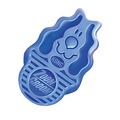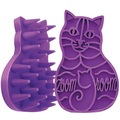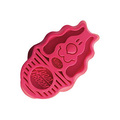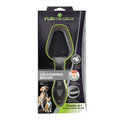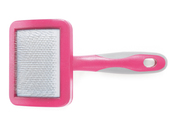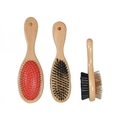Regular grooming is part and parcel of being a responsible pet owner, especially at this time of year when your pet is growing its winter coat. Not only does grooming promote coat condition and health, your pet will be a lot happier for it, which is why your grooming kit is such a solid investment.
Your pet’s coat is its protective layer and first defence against the environment, which is why it needs to be well taken care of. This includes removing the hair when it becomes loose and sheds as not only does this help the hair renewal process by creating space for new hair to grow, it stimulates the hair follicle and skin and encourages better blood flow.
 So, what brushes and tools should you have handy to tackle even the most stubborn matts and tangles? Below is a list of the top tools that should feature in every grooming arsenal – all of which can be found here at VioVet!
So, what brushes and tools should you have handy to tackle even the most stubborn matts and tangles? Below is a list of the top tools that should feature in every grooming arsenal – all of which can be found here at VioVet!
Brushes (including bristle, wire-pin and slicker brushes) - there are three main varieties on the market and the type you choose should be determined by your pet’s coat thickness and length, whether you have a cat or dog. That said, it is worth having a selection of brushes to hand for all eventualities. Bristle brushes are the most versatile and have soft, medium or firm bristles spaced closely together or far apart. The coarser the coat, the more rigid the bristles need to be.
Wire-pin brushes are best for thin, delicate coats of mid to long length, while slickers effectively groom outer coats that are thick and undercoats that are soft, dense and prone to matting. You can buy double-sided brushes that combine bristles and wire-pins for easy switching between the two.
Combs – it is helpful to have a couple of combs in your grooming kit, including a fine-toothed comb and a rubber curry comb. If your pet’s coat is tangle-free but shedding, a gentle brush through with a curry comb is probably enough, while a fine-toothed comb is a great tool for getting rid of more difficult knots in fine coats. A flea comb is also worth having in case of unwanted visitors.
 De-shedding tool – all cats and dogs shed (unless they are hairless and only shed skin) and need to be groomed regularly to clear the excess hair away and make way for regrowth. Despite what many believe about short-haired breeds being lighter shedders, the opposite is actually true, as their hairs have a shorter life-cycle and are constantly being shed and replaced. The Furminator Deshedding Tool is designed to reduce shedding by up to 90% by reaching beneath the topcoat and gently loosening and removing the undercoat.
De-shedding tool – all cats and dogs shed (unless they are hairless and only shed skin) and need to be groomed regularly to clear the excess hair away and make way for regrowth. Despite what many believe about short-haired breeds being lighter shedders, the opposite is actually true, as their hairs have a shorter life-cycle and are constantly being shed and replaced. The Furminator Deshedding Tool is designed to reduce shedding by up to 90% by reaching beneath the topcoat and gently loosening and removing the undercoat.
Nail clippers – occasionally your pet will need its nails trimming and your clipping skills will be called upon. Having a good pair of clippers is incredibly useful and it is important to choose a style designed for your dog’s size to make your life easier and, more importantly, to help you avoid accidents. Choose a pair with soft cushioned handles and thumb grips for comfortable, easy handling.
Shampoos – alongside brushing and clipping, bathing is an important part of grooming, however you don’t want to be doing it too often as it can strip the natural oils from your pet’s coat. Cats aside as we all know how much they love baths (not!), dogs will probably need bathing every couple of months unless they decide to roll in a puddle or enjoy a particularly muddy walk. For dogs with sensitive skin or very dense coats, it might be better to allow the mud to dry before brushing it away. Choose a shampoo that is mild but deep-cleansing and ensure it is thoroughly rinsed off after every bath.
 If you have any grooming tips of your own, please share them with our other readers! Equally, we'd love to hear your grooming tool recommendations if there's a particular product you swear by :) Feel free to email me or comment below: [email protected].
If you have any grooming tips of your own, please share them with our other readers! Equally, we'd love to hear your grooming tool recommendations if there's a particular product you swear by :) Feel free to email me or comment below: [email protected].
Written by: Hannah

